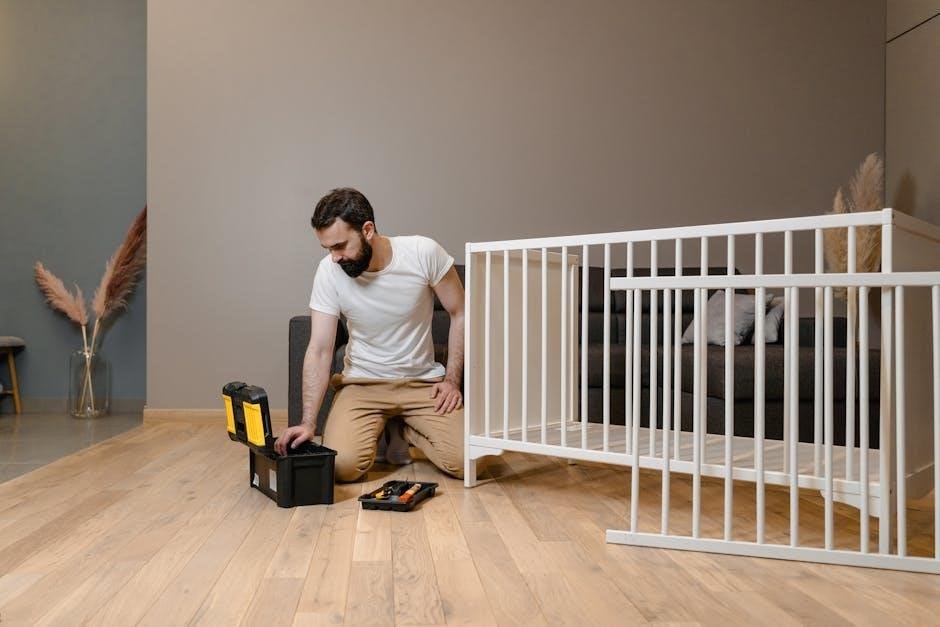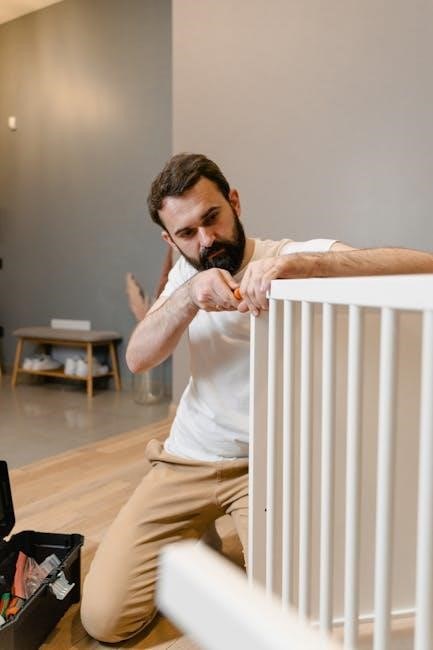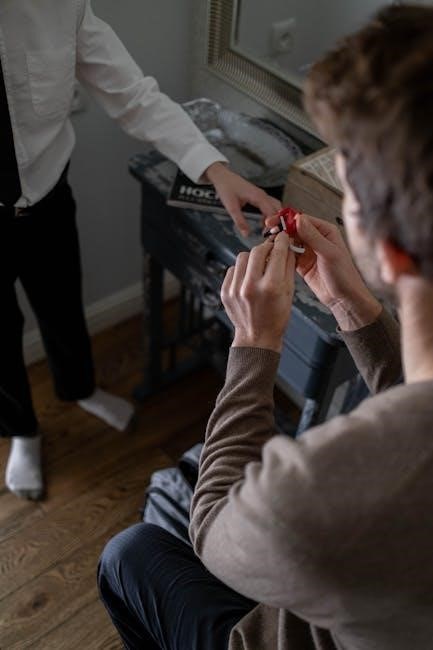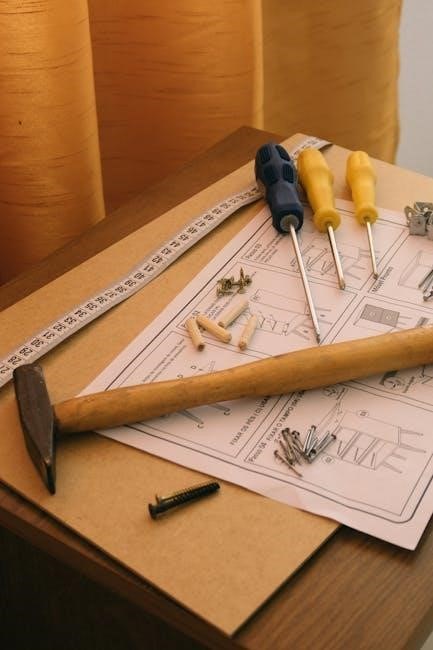Welcome to the Delta 6-in-1 Crib assembly guide! This versatile crib offers multiple conversions, ensuring it adapts to your child’s growth. Follow these instructions carefully to ensure stability, safety, and proper assembly. Taking the time to assemble the crib correctly will provide a secure and comfortable environment for your baby. Let’s get started!
1.1 Overview of the Delta 6-in-1 Crib
The Delta 6-in-1 Crib is a versatile and multi-functional baby furniture piece designed to grow with your child. It offers six different configurations, including a standard crib, toddler bed, daybed, and full-size bed, providing long-term value. The crib is built with durability in mind, featuring a sturdy frame and adjustable mattress height settings. It also includes optional features like a changing station and storage drawer for added convenience. Designed with safety and style, the Delta 6-in-1 Crib meets rigorous safety standards and offers a sleek, modern design to fit various nursery themes. Its adaptability makes it a practical choice for families.
1.2 Importance of Following Assembly Instructions
Following the Delta 6-in-1 Crib assembly instructions is crucial for ensuring the crib is assembled correctly and safely. Proper assembly guarantees the crib’s structural integrity, preventing potential hazards for your child. Incorrect assembly can lead to instability, which may result in accidents or injuries. By adhering to the instructions, you ensure all parts are securely fastened, and the crib meets safety standards. Additionally, following the guide helps avoid costly mistakes, such as damaging parts or stripping screws. This step-by-step process also saves time and reduces frustration, ensuring a smooth and efficient assembly experience. Always prioritize your child’s safety by assembling the crib as instructed.
1.3 Safety Precautions Before Assembly
Before starting the assembly of the Delta 6-in-1 Crib, ensure a safe working environment. Clear the area of clutter or tripping hazards and protect the floor with a soft cloth or old sheets to prevent damage. Wear safety gloves to avoid cuts or splinters and safety glasses if using power tools. Keep children and pets away to prevent accidents. Read the manual thoroughly to understand each step and avoid mistakes. Use only the tools and hardware provided to ensure proper fit and safety. Inspect all parts for damage before assembly to prevent issues later. Work patiently and carefully to avoid rushing, which could lead to errors.
Tools and Materials Required
To assemble the Delta 6-in-1 Crib, you will need an Allen wrench, screwdriver, and the hardware provided in the packaging, such as bolts, screws, and washers.
2.1 List of Tools Needed for Assembly
To assemble the Delta 6-in-1 Crib, you will need a 3mm and 4mm Allen wrench for securing bolts, a flathead screwdriver for adjusting parts, and a Phillips screwdriver for tightening screws. Additionally, a rubber mallet may be useful for gently tapping pieces into place without causing damage. Ensure all tools are within easy reach to streamline the process. Optional items include clamps to hold sections steady while fastening. Having these tools ready will ensure a smooth and efficient assembly experience. Always double-check the instructions for specific tool requirements to avoid delays. Proper tools are essential for safety and structural integrity.
2.2 Identifying All Parts and Components
Before assembling the Delta 6-in-1 Crib, it’s crucial to identify and organize all parts and components. Start by locating the crib frame, side panels, and front/back rails. These are the main structural elements. Next, identify the mattress support board and bed board, which provide the base for the mattress. Additional components include the wheels and casters for mobility, as well as hardware like bolts, screws, and Allen wrenches for securing the parts together. If your crib includes a changing station or storage drawer, set those components aside for later steps. Refer to the provided diagram to match each part with its description and ensure nothing is overlooked. This step ensures a smooth assembly process and prevents delays.
2.3 Checking for Damaged or Missing Parts
Before starting the assembly, thoroughly inspect all parts for damage or wear. Check the crib frame, side panels, and rails for any dents, cracks, or scratches. Ensure all hardware, such as bolts, screws, and Allen wrenches, is included and undamaged. Examine the mattress support and bed board for any signs of damage that could compromise safety. If any part is damaged or missing, assembly should not proceed. Instead, contact Delta customer support for replacements. Cross-reference the parts list with the items you’ve unpacked to confirm everything is accounted for. This step is critical to ensure the crib’s structural integrity and your child’s safety;

Step-by-Step Assembly Process
Follow the detailed instructions to build the crib systematically. Start with the frame, then attach side panels, rails, and mattress support. Ensure all parts align correctly.
3.1 Unpacking and Organizing the Components
Carefully open all boxes and inspect for damage. Lay out all parts on a flat surface for easy access. Use the inventory list to verify that all components are present. Separate hardware like bolts, screws, and Allen wrenches into labeled containers. Organize larger parts, such as crib frames, side panels, and mattress supports, by category. This step ensures a smooth assembly process by reducing time spent searching for parts later. Double-check for any missing items before proceeding. Protect the floor with a soft cloth or mat to prevent scratches during assembly. Gather all tools and keep them within reach.
3.2 Assembling the Crib Frame
Begin by attaching the crib legs to the frame using the bolts and washers provided. Ensure the legs are evenly spaced and securely tightened with the Allen wrench. Next, align the side rails with the frame’s pre-drilled holes and screw them into place. Tighten firmly but avoid overtightening, which could strip the screws. Attach the front and back rails, making sure they are level and properly aligned. Use the Allen wrench to tighten all bolts and screws progressively, ensuring the frame remains stable. Double-check that all connections are secure before proceeding to the next step. This step forms the foundation of the crib, so accuracy is crucial for safety and stability.
3.3 Attaching the Side Panels and Rails
To attach the side panels and rails, first, locate the pre-drilled holes on the crib frame where the panels will be secured. Align the side panels with these holes, ensuring they are flush with the frame’s edges for a snug fit. Use the provided screws or bolts to fasten the panels, tightening them firmly with a screwdriver or Allen wrench. Be cautious not to overtighten to avoid damaging the material. Next, install any additional support rails, following the manual’s diagrams for correct positioning. Ensure all connections are level and aligned to prevent instability. Secure any locking mechanisms or safety latches according to the instructions to guarantee the panels are safely in place. After attaching, perform a stability check by gently shaking the crib to verify everything is secure. If any part feels loose, revisit the connections to tighten as needed. Properly attaching the side panels and rails is essential for the crib’s structural integrity and safety.
3.4 Securing the Mattress Support and Bed Board
To secure the mattress support and bed board, begin by aligning the mattress support with the crib frame. Locate the pre-drilled holes and use the provided bolts to attach it firmly. Tighten the bolts using a screwdriver or Allen wrench until snug. Next, position the bed board on top of the mattress support, ensuring it fits perfectly. Attach the bed board using the screws provided, following the manual’s instructions. Double-check that all connections are secure and even. Finally, ensure the mattress support and bed board are level and stable. This step ensures proper support and safety for the mattress, guaranteeing a secure sleeping surface for your baby. Always verify stability after assembly.
3.5 Installing the Wheels and Casters
Begin by attaching the wheels to the crib’s legs using the provided bolts. Ensure each wheel is securely fastened, but do not overtighten. Next, insert the casters into the wheel bases, making sure they click into place firmly. Once installed, test the mobility by gently pushing the crib to ensure smooth movement. For safety, check that the wheels are properly aligned and the crib remains stable when moved. Tighten any loose connections if necessary. Finally, verify that the wheels are locked in place when the crib is stationary to prevent accidental movement. This step enhances portability while maintaining safety and stability. Always test the wheels after installation.
3.6 Tightening All Bolts and Screws
Once all components are assembled, use an Allen wrench to tighten all bolts and screws securely. Start with the crib frame, ensuring all joints are firm and stable. Next, tighten the side panels, rails, and mattress support. Avoid overtightening, as this may damage the wood or strip the screws. Work methodically, checking each section to ensure no bolts are loose. Pay extra attention to weight-bearing areas, such as the mattress support and bed board. After tightening, gently rock the crib to verify stability and recheck any parts that feel loose. Properly tightened hardware ensures safety and prevents structural issues. Double-check all connections before final use.

Converting the Crib to Different Configurations
The Delta 6-in-1 crib offers versatile conversions to suit your child’s growth, from a toddler bed to a full-size bed, using conversion kits for seamless transitions.
4.1 Converting to a Toddler Bed
To convert the crib to a toddler bed, start by removing the crib side and installing the toddler rail, ensuring it is securely attached using the provided hardware.
This configuration allows your child to safely transition to a larger bed while maintaining the familiar design of the crib. Always use the conversion kit specifically designed for the Delta 6-in-1 crib to ensure compatibility and safety.
Double-check that all bolts are tightened properly and that the bed is stable before allowing your child to use it. A toddler mattress is recommended for this setup.
Follow the assembly manual carefully to avoid errors and ensure a smooth transition.
4.2 Converting to a Daybed
To convert the crib to a daybed, remove the toddler rail (if installed) and attach the daybed rail using the provided hardware.
Ensure all bolts and screws are securely tightened to maintain stability.
The daybed configuration offers a spacious sleeping area while retaining the crib’s original design elements.
Reattach the side panels to complete the transition, ensuring proper alignment and support.
Double-check all connections for tightness and stability before use.
A standard twin mattress is recommended for this configuration, providing optimal comfort and safety for your child.
4.3 Converting to a Full-Size Bed
To convert the crib to a full-size bed, start by detaching the crib sides and removing any toddler bed or daybed components.
Attach the full-size bed side rails to the crib frame using the provided bolts and screws, ensuring they are tightly secured.
Next, connect the full-size bed frame to the crib base, following the manufacturer’s instructions for proper alignment.
Place the full-size mattress on the bed frame, making sure it fits snugly and aligns with the edges of the bed.
Double-check all connections for stability and safety before allowing your child to use the bed.
This configuration is ideal for older children, offering ample space and comfort while maintaining the crib’s durability.
Always use a standard full-size mattress to ensure proper fit and support.
Regularly inspect the bed frame for any loose parts or wear and tear to maintain safety and functionality.
4.4 Converting to a Crib with Changing Station
To convert your Delta 6-in-1 crib into a crib with a changing station, begin by attaching the changing station module to the crib frame.
Ensure the changing station is aligned with the designated attachment points on the crib.
Secure the station using the provided bolts and screws, tightening them firmly to avoid any wobbling.
Place the changing pad on the station, making sure it fits snugly and is level.
Double-check the stability of the entire unit by gently rocking it back and forth.
Always follow the manufacturer’s weight and size guidelines for the changing station.
Keep essential items like diapers and wipes within easy reach for convenience.
Regularly inspect the changing station for loose parts or wear and tear to ensure safety.
This configuration offers a practical and space-saving solution for parents.
4.5 Converting to a Crib with Storage Drawer
To convert your Delta 6-in-1 crib into a crib with a storage drawer, start by attaching the drawer module to the base of the crib.
Align the drawer with the pre-drilled holes on the crib frame and secure it using the provided screws.
Ensure the drawer glides smoothly and is properly aligned for even weight distribution.
Place baby essentials like linens, toys, or diapers inside the drawer for easy access.
Check the weight limit specified in the manual to avoid overloading the drawer.
This feature provides a practical storage solution while maintaining the crib’s functionality.
Regularly inspect the drawer’s hardware for tightness and stability.
This configuration is ideal for optimizing space in a nursery.
Safety Tips and Guidelines
Always ensure the crib is stable and level to prevent tipping. Tighten all bolts and screws regularly to maintain structural integrity.
5.1 Ensuring Stability and Structural Integrity
Ensuring the crib’s stability is crucial for your baby’s safety. Always tighten all bolts and screws firmly during assembly and check them periodically. Use a level to confirm the crib is even and properly balanced. Place the crib on a firm, flat surface, avoiding soft flooring like carpets or rugs. Ensure the mattress fits snugly within the crib frame without any gaps. Never overload the crib beyond the recommended weight limit. Regularly inspect the crib for signs of wear or damage, addressing any issues promptly; Keep the crib away from windows or blinds to prevent accidental entanglement or falls. Stability ensures a safe sleeping environment.
5.2 Checking for Loose Joints or Gaps
Regularly inspect the crib for loose joints or gaps, as these can compromise its stability. Use a screwdriver to tighten any bolts or screws that feel loose. Pay particular attention to the connections between the side panels, rails, and frame. Gaps between parts can create hazards, so ensure all components fit snugly together. If you notice any gaps, check if the parts are aligned correctly or if shims are needed. Always refer to the manual for guidance on proper tightening torque to avoid over-tightening, which could damage the crib. Checking for loose joints and gaps ensures the crib remains structurally sound and safe for your baby. Regular inspections are essential for long-term safety.
5.3 Ensuring Proper Mattress Fit and Firmness
A properly fitting and firm mattress is crucial for your baby’s safety and comfort. Measure the mattress to ensure it fits snugly inside the crib, leaving no gaps. The standard crib mattress size is 52 inches by 28 inches. A firm mattress is essential to prevent suffocation risks. Test the firmness by pressing on the surface; it should feel solid and unyielding. Avoid using soft bedding or padding, as these can pose hazards. Use a tight-fitting crib sheet to maintain a smooth surface. Regularly inspect the mattress for signs of wear or sagging. A well-fitting, firm mattress ensures a safe sleeping environment for your child. Always follow the manufacturer’s guidelines for mattress compatibility and safety standards.

5.4 Avoiding Hazardous Materials and Finishes
Ensure all materials and finishes on the crib are non-toxic and safe for your baby. Look for certifications like ASTM or JPMA, which guarantee compliance with safety standards. Avoid cribs with lead-based paints, phthalates, or formaldehyde. Check for a Greenguard Gold certification, indicating low chemical emissions. Opt for cribs made from solid, sustainably sourced wood or metal frames with a durable, non-toxic finish. Avoid using DIY paints or finishes unless they are specifically labeled as safe for cribs. Regularly inspect the crib for peeling paint or worn finishes, and address these issues promptly. A safe, chemical-free environment ensures your baby’s health and well-being. Always follow the manufacturer’s guidelines for safe materials.

Troubleshooting Common Assembly Issues
Identify and resolve assembly challenges quickly. Consult the manual for guidance on misaligned parts, missing hardware, or unstable sections. Tightening loose joints and verifying proper alignment ensures safety and durability.
6.1 Dealing with Misaligned Parts
If parts don’t align properly, stop and re-examine the instructions. Ensure all components are correctly identified and positioned. Check for any damage or bent pieces, as these can cause misalignment. Verify that all previous steps were followed accurately, as skipping a step may lead to this issue. If a part still doesn’t fit, consider consulting online assembly videos or contacting Delta customer support for guidance. Patience and careful re-evaluation are key to resolving alignment problems effectively. Proper alignment is crucial for the crib’s stability and safety, so take the time to address any issues before proceeding further with the assembly.

6.2 Resolving Issues with Missing or Damaged Hardware
If you encounter missing or damaged hardware during assembly, stop immediately and assess the situation. Double-check the packaging to ensure all parts were included. If items are missing, contact Delta customer support for replacements. For damaged hardware, do not attempt to use it, as this could compromise the crib’s safety. Replace damaged parts with genuine Delta components to maintain structural integrity. If hardware is difficult to find, consider reaching out to local hardware stores for compatible alternatives. Always follow manufacturer guidelines to ensure the crib remains stable and secure for your child. Proper resolution of hardware issues is crucial for safety and longevity of the crib.
6.3 Fixing Wobbly or Unstable Sections
If you notice any wobbly or unstable sections during or after assembly, address the issue immediately to ensure your crib’s safety. Check all bolts and screws to ensure they are tightly secured, following the recommended torque specifications. Re-examine the frame alignment to confirm all parts are properly connected and seated. If instability persists, inspect for any gaps or misaligned joints and adjust accordingly. For minor wobbles, use shims or adjust the floor levelers to stabilize the crib on uneven surfaces. Finally, re-tighten all connections and test the crib’s stability before use.
6.4 Addressing Difficult-to-Tighten Bolts or Screws
If you encounter bolts or screws that are difficult to tighten during the assembly of your Delta 6-in-1 crib, start by ensuring you’re using the correct size of Allen wrench or screwdriver. Applying a small amount of silicone-based lubricant to the threads can reduce friction and make tightening easier. Check for any obstructions, such as wood shavings or debris, and remove them before proceeding. If the bolt still doesn’t tighten properly, gently tap it into place with a soft-faced hammer to align it correctly. Avoid using excessive force, as this could strip the screw head or damage the surrounding material. If the issue persists, consult the manual or contact Delta customer support for assistance.

Maintenance and Upkeep

Regularly clean the crib with a damp cloth to remove dirt and stains. Avoid harsh chemicals to maintain the finish and safety of the material.
7.1 Cleaning the Crib Regularly
Dust all surfaces weekly and wipe with a mild soap solution. Dry thoroughly to prevent moisture buildup and potential damage to the wood or metal parts.
7.2 Inspecting for Wear and Tear
Check for loose screws, scratches, or dents. Address any damage promptly to ensure the crib remains stable and safe for your child to use.
7.3 Storing Assembly Instructions for Future Use
Keep the manual in a safe, dry place. Refer to it for maintenance tips or disassembly instructions if needed for moving or reconfiguring the crib later.
Regular cleaning is essential to maintain the hygiene and safety of your Delta 6-in-1 crib. Use a soft, damp cloth to wipe down all surfaces, paying attention to areas around the mattress support and side rails. Avoid harsh chemicals or abrasive cleaners, as they may damage the crib’s finish. For stubborn stains, mix a mild detergent with warm water and gently scrub the area. Dry the crib thoroughly after cleaning to prevent moisture buildup. Clean the crib at least once a week, or more frequently if your child is prone to spills or accidents. Always spot-clean spills immediately to prevent them from becoming stubborn stains.
Regularly inspecting your Delta 6-in-1 crib for wear and tear is crucial to ensure your child’s safety and the longevity of the furniture. Check the frame for any cracks or dents, and examine the joints for looseness. Inspect the hardware, such as bolts and screws, for rust or damage. Look for signs of wear on moving parts, like the wheels or drawer mechanisms. Additionally, check the mattress support and bed board for warping or sagging. Address any issues promptly by tightening loose parts or replacing damaged components. This routine maintenance will help prevent potential hazards and keep the crib stable and secure for years to come.

Properly storing the Delta 6-in-1 crib assembly instructions ensures easy access for future reference or disassembly. Keep the manual in a safe, dry location, such as a plastic folder or binder. Consider digitizing the instructions by scanning or saving them as a PDF on your device or cloud storage. This prevents loss or damage and allows sharing with others, like family members or caregivers. Additionally, store any warranty information and hardware specifics alongside the instructions. Regularly reviewing and updating your storage method ensures everything remains organized and accessible when needed. This step is crucial for maintaining convenience and preparedness over time.
Additional Resources and Support
For further assistance, Delta offers online manuals, customer support, and instructional videos. Visit their official website or contact their helpline for guidance. Additional resources include detailed FAQs and troubleshooting guides to ensure a smooth assembly process.
- Online Manuals: Download PDF guides from Delta’s official website.
- Customer Support: Reach out via phone or email for queries.
- Video Tutorials: Watch step-by-step assembly videos on YouTube.
8.1 Accessing Online Manuals and Guides

Accessing online manuals and guides for the Delta 6-in-1 crib is a convenient way to ensure you have the most up-to-date assembly instructions. Visit the official Delta Children website, where you can search for your specific crib model and download the PDF manual. Additionally, many retailers, such as Amazon or Buy Buy Baby, provide access to product manuals on their websites. If you’ve misplaced your physical copy, these online resources are invaluable. Always verify the source to ensure you’re downloading the correct guide for your crib model. Online manuals often include interactive features, such as zoom and search functions, making it easier to navigate and find specific instructions. This ensures you can assemble your crib with confidence and accuracy. Regularly checking for updates or revised versions is also a good practice to stay informed about any changes or improvements to the assembly process.
8.2 Contacting Delta Customer Support
If you encounter any issues during the assembly or have questions about your Delta 6-in-1 crib, contacting customer support is a great option. Delta offers multiple ways to reach their support team, including phone, email, and live chat through their official website. Be sure to have your crib’s model number and a detailed description of your issue ready to ensure a smooth and efficient resolution. The customer support team is trained to assist with assembly queries, missing parts, or conversion guidance. For the best experience, contact them during business hours, typically Monday through Friday, 9 AM to 5 PM EST.
8.3 Watching Assembly Videos and Tutorials
Watching assembly videos and tutorials can significantly simplify the process of assembling your Delta 6-in-1 crib. These visual guides provide step-by-step demonstrations, making it easier to understand complex instructions. Videos often highlight key details, such as proper alignment of parts and correct tightening techniques. You can find official Delta assembly videos on their website or YouTube. Additionally, third-party tutorials from experienced users or professionals may offer helpful tips. Pause and rewind as needed to follow along at your own pace. Visual guidance reduces the risk of errors and ensures a smoother assembly experience. Take advantage of these resources to build confidence and ensure your crib is assembled safely and correctly.
Thank you for following the Delta 6-in-1 crib assembly guide. Your effort ensures safety, functionality, and a cozy space. Enjoy your versatile crib!
9.1 Final Checklist Before Use
Before placing your baby in the crib, ensure all components are securely assembled and tightened. Verify that the mattress support is properly installed and the mattress fits snugly. Check that all bolts, screws, and hardware are tightened to avoid any wobbling or instability. Inspect the crib for any sharp edges or gaps. Test the crib’s stability by gently rocking it to ensure it remains firm. Confirm that all safety features, such as the crib rail height and any latches for convertible configurations, are functioning correctly. Double-check that all wheels or casters are securely attached and locked. Finally, ensure the crib is placed on a firm, flat surface away from hazards like curtains or blinds. Read the safety manual thoroughly for any additional guidelines.
9.2 Enjoying Your Newly Assembled Crib
After completing the assembly, take a moment to admire your handiwork and feel a sense of accomplishment. Your Delta 6-in-1 crib is now ready to provide a safe, comfortable, and versatile space for your baby to sleep, play, and grow.
The crib’s multiple configurations ensure it adapts to your child’s needs as they develop, offering lasting value and convenience;
Once everything is set up, place a firm, snug-fitting mattress inside, and add soft bedding to create a cozy environment.
Finally, step back and enjoy the peace of mind knowing your baby has a sturdy, well-assembled crib to rest in. This milestone marks the beginning of countless memories and a safe haven for your little one.



0 Comments